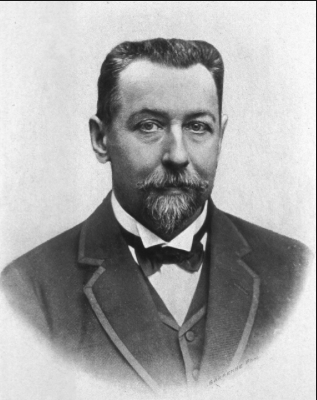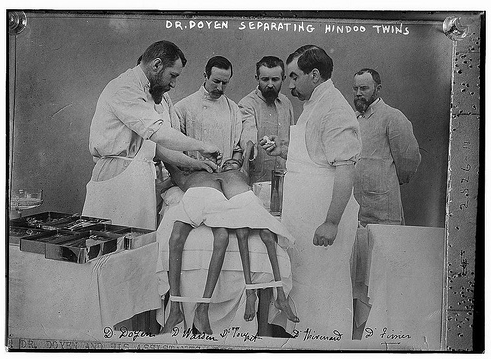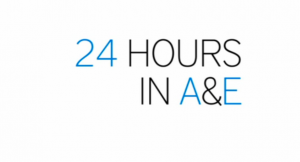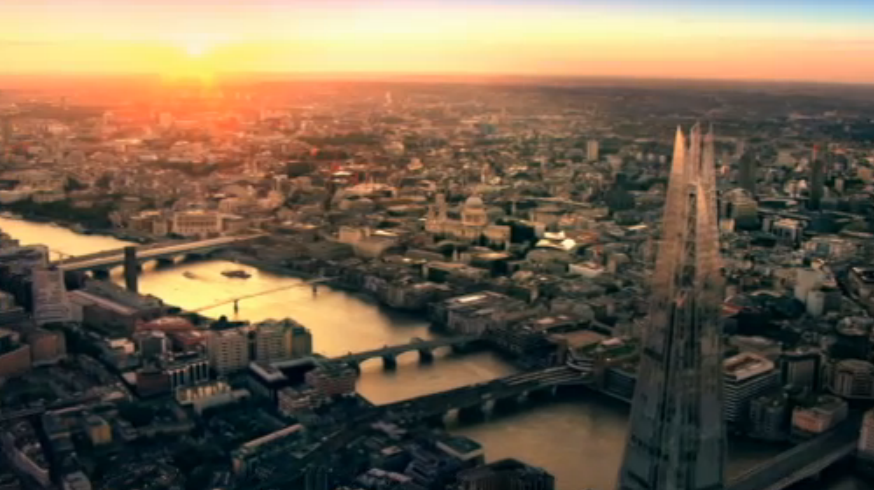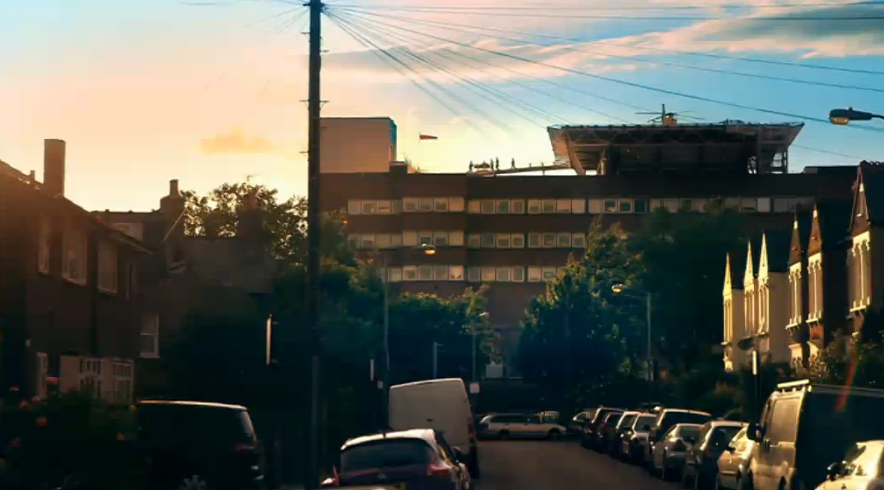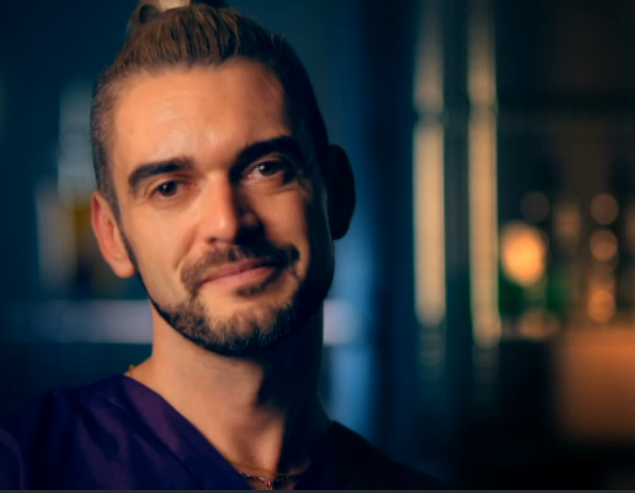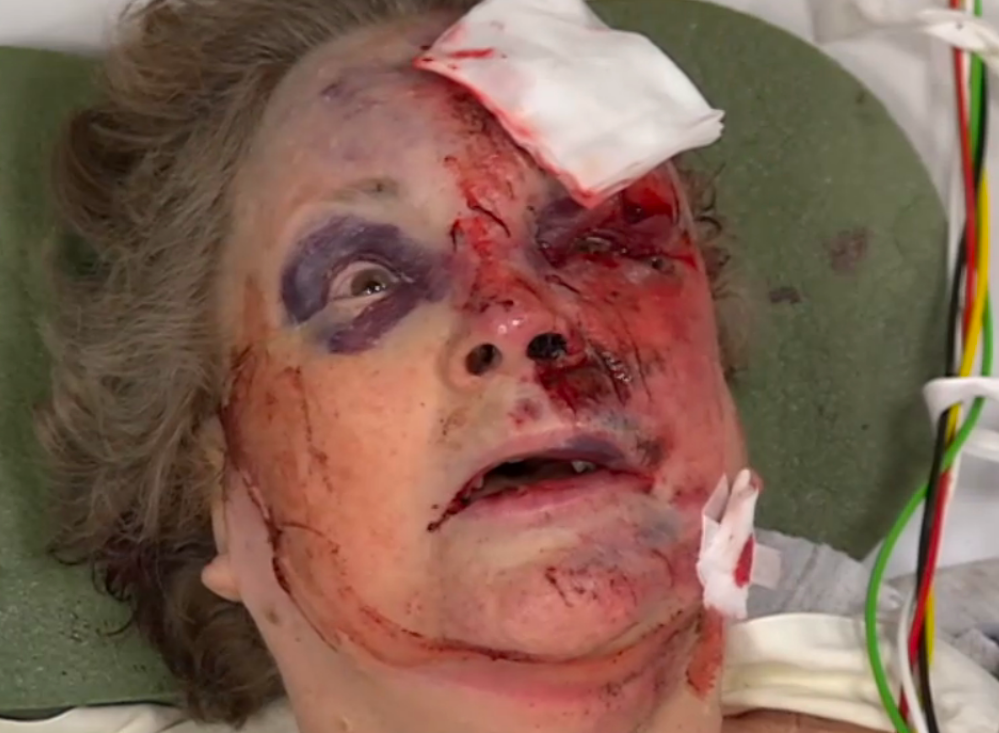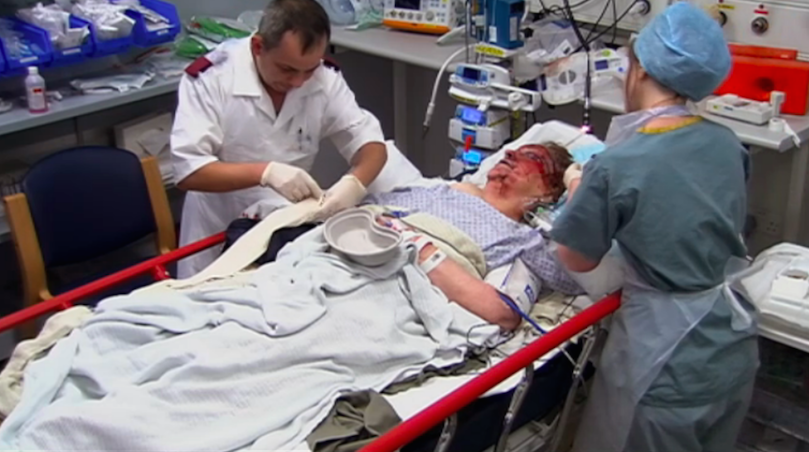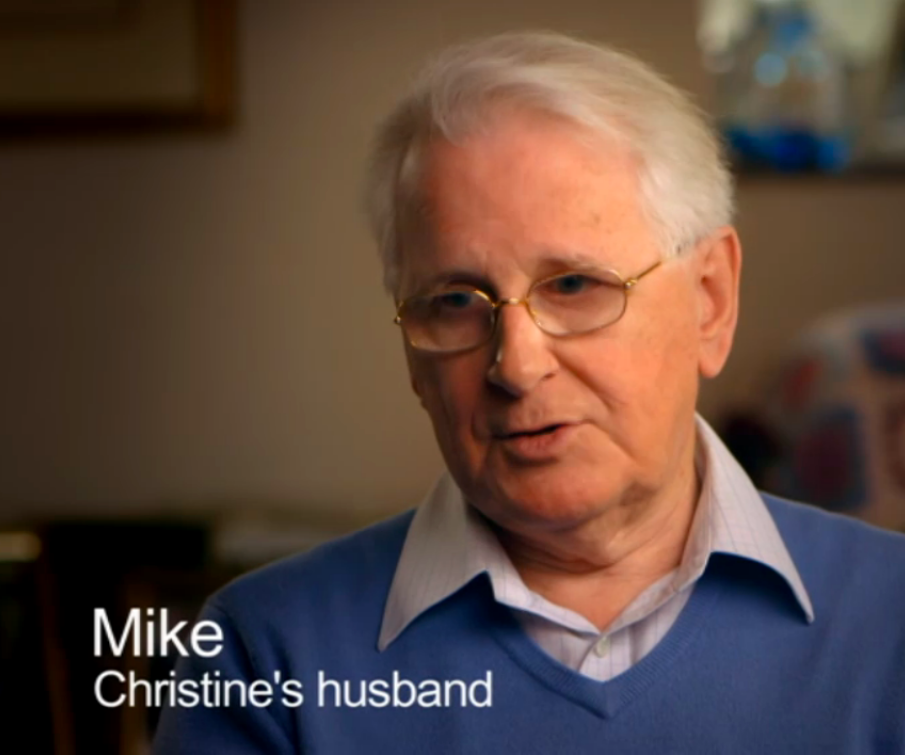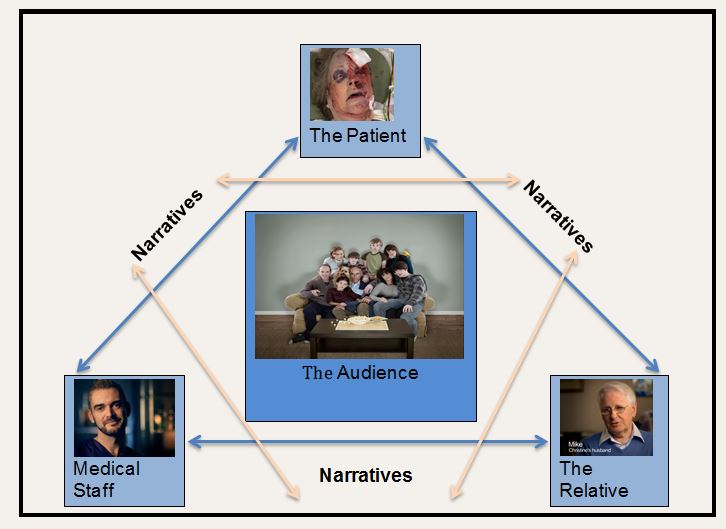Life as Narrativised in ‘24 Hours in A&E’: Early documentary film to modern-day docusoap.
WARNING – Contains graphic images of traumatic injury
A place where life, love, and loss unfold every single day.
All the patients you are about to see were treated in one 24 hour period’.
(Channel 4, 2015)
This paper will focus on the role of narratives in 24 Hours in A&E (Channel 4, 2015). In an attempt to understand these narratives, this paper will take a look at early surgical film, and its interest to the public as a form of attraction. This paper will then look at the role of docusoap, including structure and function, including the vehicle of narrative to tell stories. Exposure of a storyline in a recent episode (Channel 4, Series 8, Episode 8, ‘Free Fall’, 2015) will be described, including figures to illustrate points of narrative interest. This paper will then draw upon the issues raised from early medical cinema through to docusoap, and give a brief critique of the narratives explored in an episode of 24 Hours in A&E.
The role of film as an aid to medical research can be rooted in documentary cinema (Ostherr, 2012). In the early twentieth century, anatomy, physiology, and dissection of the body were written about extensively in books and journals of the time. The most effective form of surgical medical education was seeing the event live (Ostherr, 2012).
It is here that we turn to Eugène-Louis Doyen (1859-1916) (Figure 1), a famous Parisian surgeon.
Doyen famously used photographs to publicise his surgical techniques to his fellow peers (Ostherr, 2012; Van Dijck, 2015). It was therefore no surprise to these same peers that after viewing the Lumière Brothers first public ‘moving pictures’ screening, Doyen was keen to use these same moving pictures to capture his surgical skills (Clark, 2015; McKernan, 2015).
It was noted that, at the ‘Clinical Congress of Surgeons, 1910’, Doyen provided ‘wet clinic’ surgical demonstrations. These demonstrations on cadavers and living participants, were highly anticipated and demand to attend was high (Ostherr, 2012). With demand to understand his work proving profitable, Doyen decided to film his surgical procedures for medical educational advancement (Clark, 2015; McKernan, 2015; Ostherr, 2012).
To do this he recruited two ‘opèrateurs cinematographes’, Clement Maurice and Ambroise-François Paraland (Van Dijck, 2015, p.543). Doyen converted his operation suite in a medical film studio, ‘the walls, for instance were covered with special paint to avoid unintended light reflection, and in addition to the room’s natural light source, four electric lamps assured sufficient light for both surgeons and cameras’ (Van Dijck, 2015, p.543).
The separation of the Neik Sisters, who were Siamese twins, was Doyen’s most famous educational surgical film (Figure 2).
Unfortunately for Doyen, although successful in bringing moving pictures to his medical surgeries (and with the disapproval of many of his peers), his reputation was scarred when it was found that his surgical films were being secretly sold by his cinematographer Paraland to fairgrounds, as a form of freak show ‘attraction’ for the curious lay population (McKernan, 2015).
One hundred years on and the popularity of educational medical films has found a new form in the medical TV ‘docusoap’, itself a form of medical ‘attraction’ for general consumption (Kilborn, 2013; Kilborn, Hibberd and Boyle, 2001; Beck, Hellmueller and Aeschbacher, 2012).
Stemming from direct documentary, docusoap is a form of reality TV, which is commissioned for production under the overarching genre of Factual Television, and which rose to prominence between 1996 and 2000 (Kilborn, Hibberd and Boyle, 2001). Some popular examples of the genre include Vets in Practice (BBC 1, 1996-2002); the Educating Essex franchise (Channel 4, 2011-ongoing) and 24 Hours in A&E (Channel 4, 2011-ongoing). Docusoaps are often set in ‘a particular organisation, or pursuing some form of professional activity’ (Kilborn, 2000, p. 112) such as an airport, a hospital, an academic institution. There are also a plethora of international factual entertainment formats, which are a hybrid of docusoaps and ‘reality’ television (Kilborn, 2013) such as Big Brother, Jersey Shore (an example of the ‘structured reality’ format), and Bauer Sucht Frau.
Docusoap itself is considered to be a hybrid form of factual entertainment; Kilborn (2000, p. 112) states that ‘docusoaps combine features associated with ‘classic’ observational documentary with structuring techniques that are regularly deployed in soap-opera narratives’.
Docusoaps often carry an extended opening sequence, to locate an audience in the context of the program and to familiarise the cast of characters, a device not dissimilar to that used in soap opera (Donnelly, 2001).
Beck, Hellmueller and Aeschbacher (2012) cite Nabi (2007, pp. 372-373), when considering the key elements utilised to construct a docusoap, these include ‘(a) a portrayal of themselves, (b) filmed at least in a part of their living or working environment rather than a set, (c) without a script (or at least pretending to be without a script), (d) with events placed in a narrative context, (e) for the primary use of entertainment’. Queens University (2015, p.1) also note that some techniques employed in docusoap include, ‘interviewing, the ‘voice of God’, dramatic reconstructions, editing for heightened suspense and storylines which follow from one week to the next’.
The characters are at the centre of docusoaps, and these are (usually) ordinary people chosen to be observed, narrate (Beck, Hellmueller and Aeschbacher, 2012), and to ‘wash their dirty linen in public’ (Matthews, 2006). There is often an underlying desire for celebrity and fame (Donnelly, 2001), and docusoaps have been blamed for encouraging the ‘15 minutes of fame syndrome’ (Kilborn, 2013; Queens University, 2015). It is this ‘ordinary to famous’ journey which has proven demonstrably popular with audiences (Hill, 2000).
There are two key strategies deployed to create a docusoap that are imperative to explore in this paper; these include the development of narrative (Kilborn, 2000), and the role of editing (Kilborn, 2013).
In an attempt to ‘create’ good narratives, interesting characters appear to be sophisticatedly interwoven within a structured sense of temporality (i.e. their lives over a period of time) (Kilborn, 2013). Intrinsic to the docusoap format is an observation of ordinary people’s lives, unfolding in familiar environments and under a microscope, encouraging them to engage in a confessional mode (‘a tell all exposé of life’)(Thomas, 1996).
These lived experiences/narrated lives are used to create a new ‘formatted form of reality’ (Kilborn, 2013, p.294), by editing them for entertainment value (Thomas, 1996) e.g. the soap in docusoap.
This newly-constructed form of reality suggests an inherent ‘lack of truth’: constructing a new soap-narrative ‘truth’ for the purposes of entertainment. Thomas (1996) notes concern with the creation of docusoaps and their narratives in connection with documentary suggesting that the ‘truth we are representing becomes secondary to the primary role of televisual ‘entertainment’ (p.423).
With these theoretical perspectives in mind, this paper will now present a brief narrative description of an episode of 24 Hours in A&E (Channel 4, 2015) entitled ‘Free Fall’ (Season 8, episode 8, aired on 25th February 2015, at 9.00pm, Channel 4). One narrative storyline embedded within this episode will be explored.
The overall theme of the episode is about love between parents and their children; however the single narrative that this essay will focus upon, is about the love of a couple, after their children have gone, and living in their old age.
24 Hours in A&E is a medial docusoap on Channel 4, utilised in one of the channels midweek primetime television slots (Figure 3: Program Logo).
Channel 4 advertises 24 Hours in A&E under the genre of factual entertainment (Channel 4, 2015). The series won a ‘Royal Society Television Award for a Documentary Series’ (Guardian, 2012). The program now in season 8, is filmed at St Georges Hospital, Tooting, London. Location shots situate the audience with a montage of London and St Georges Hospital (See Figures 4, 5 and 6). (25)
While the montage rolls, a ‘voice of God’ modality openings the program:
‘A place where life, love, and loss unfold every single day. All the patients you are about to see were treated in one 24 hour period’.
(Channel 4, 2015)
The opening sequence utilising characters (patients and medical staff) that are central to the season’s narratives. The opening sequence not only provides us with an insight into the lives of the patients, but also the medical professionals that treat those patients.
At the same time ‘talking head’ narratives engage us emotionally from the offset, providing a personalised and human window onto the working life of an A&E department.
A voiceover of a consultant doctor states:
‘A lot of really bad things happen to a lot of really good people, and you don’t think it’s going to be you’.
We are then introduced to our consultant Rhys (Figure 7), who engages by talking directly into the camera:
‘We see situations where someone’s life has just been turned upside down. People always try and remember what the last conversation was, or the last words that that person said to them… and I suppose it’s so much nicer if those last words were, I love you’.
As an audience, we are emotionally hooked. The docudrama can start.
Each episode revolves a 24 hours period in an A&E department (adhering to docusoap format, see previous references). A clock lets us know the time of the day within those 24 hours. Anticipation focuses on the arrival of new patients and ultimately the emergency ‘red phone’ ringing (Figure 8). If the red phone rings, it signals that a serious case is about to arrive, raising the stakes of the drama.
The narrative of a story develops thus; the red phone rings, medical staff answer the phone, they write down the symptoms. Voiceover proceeds, “a woman in her 70’s is being brought straight to resus (resuscitation) after a fall at home. Christine fell just five feet falling into a rockery, landing on her face”. Medical jargon is discussed between the paramedic and the consultant, and then we meet Christine (Figure 9) – we see her surrounded by doctors (Figure 10, note similarity to Figure 2) and her husband Mike (Figure 11).
We are told in narration that this is the second time Christine has fallen in six months. The episode cuts between the medical evaluation of Christine and the narrative of Mike’s life with his wife. Mike talks empathetically about her as both a wife and a mother, and his fears of life without her, “I couldn’t imagine life without her….No, No I can’t, we have spent our entire lives together, coping on my own would be horrendous”. He is close to tears.
Medically it is revealed that Christine has a lot of bruising, a broken wrist and a lacerated eyelid.
The narrative points us towards her age and growing older. Consciously or otherwise it invites us to reflect on the things we might not be able to do in old age. Mike looks directly into the camera (talking to an unseen interviewer but also addressing the audience) and says “I don’t want to get old- we need to start living our lives a little differently. We moved our sleeping arrangements down stairs, so they are less accidents”.
We then cut to Christine, out of hospital and recovered, who surmises that “You get old, but you still feel like you are eighteen years old”. And in an emotional sign-off, Mikes says “she has the utmost care for the human race. She will find good in everyone, even you?”
As an audience, we are emotionally invested in their happiness. The final cue card of the episode (Figure 12) shows them healthy and reunited back at home.
As a brief critique of the ‘Free Fall’ episode of 24 Hours in A&E comparisons can be drawn between 1920’s ‘attraction’ cinema and this new form of medically-themed docusoap. They share characteristics which are consistently popular with a general audience; for instance, look at Figure 2, 6 and 7, examples embedded in the medicalisation of the body in traumatic states. Today however, we embed this medical attraction with personalised narratives, to soften any sense of exploitation or voyeurism.
These personalised narratives, are edited and structured around unfolding events from a triangulated perspective, a concept represented in Figure 13 (below). The audience sits centrally to all narratives and characters. The narratives intersect each other so that we (the audience) are central to every narrative that occurs from a different perspective. Even from a distance, the described triangulation and intersectionality allows the audience to fully-immerse in the program, at the centre of the action and the narrative, emotionally connected.
Hellmueller and Aeschbacher (2012, p.9) call this ‘narrative reality TV’. The ‘stars’ are medical professionals at work, and patients who are in a state of trauma. As an audience we believe in a sense of ‘truth’ existing here, because we trust these professionals, and people in pain. We are aware that it is both a constructed and an edited form of reality, for the purposes of creating heightened drama. Winston (2013) states, ‘Flaherty understood the need to make drama arise from the life being observed’ (p. 89). In essence we like these people, we know these people, and this docusoap posits relatable characters and scenarios in our front room.
In conclusion, this paper brings together new discourses surrounding the role of narrative in the medical-docusoap format. This paper has suggested that the early work of Doyen in medical education should be considered the ignition of medical ‘attraction’, in the form of medical docusoap. The current theoretical discourses surrounding the structure/form of docusoaps are evident in 24 Hours in A&E; the program conforms to many of these traditional strategies. The use of narrative is exposed to its full potential, whilst drawing upon the soap opera style drama, to keep us emotionally engaged.
To conclude, life is a narrativised reality throughout 24 Hours in A&E, triangulated with narratives and embedded structurally in the docusoap format, whilst presenting a form of ‘truth’ and ‘reality’. The characters are strong, the plot gripping, the medical staff inspiring. As a docusoap goes, it could be argued, that this is a sophisticated form of ‘narrative reality TV’.
Dr. Chris Morriss-Roberts – Senior Lecturer Podiatry
References
Beck, D., Hellmueller, L.C., Aeschbacher, N. (2012) Factual Entertainment and Reality TV. Communication Research Trends, 31 (2), pp. 4-27.
Channel 4. (2015) Channel 4. (2015) 24 Hours in A&E. London: Channel 4, 25th February 2015, Series 8, Episode 8. 4OD, Available from <http://www.channel4.com/programmes/24-hours-in-ae/on-demand/59260-006> [Accessed 26 February 2015].
Documentingreality.com. (2015) Eugène-Louis Doyen. [Internet]. Available from < http://www.documentingreality.com/forum/f226/surgery-photos-circa-1890-1900-a-69202/> [Accessed 5 March 2015].
Donnelly, K. (2001) ‘Documentary’, in Creeber, G. (ed.) The Television Genre Film Book. London: British Film Institute, pp. 124-139.
Guardian. (2012) RTS programme awards 2012: full list of winners. [Internet]. Available from <http://www.theguardian.com/media/2012/mar/21/rts-programme-awards-2012> [Accessed 5 March 2015].
Hill, A. (2000) ‘Fearful and Safe: Audience response to British reality programming’, in Izod, J., Kilborn, R. and HIbberd, M. (eds.) From Grierson To The Docu-Soap: Breaking Boundaries. Luton: University of Luton Press, pp. 111-121.
Kilborn, R. (2013) ‘Docusoaps: The Ordinary Voice as Popular Entertainment’, in Winston, B. (ed.) The Documentary Film Book. London: Palgrave Macmillan and The British Film Institute, pp. 291-298.
Kilborn, R. (2000) ‘The docu-soap: A critical assessment’, in Izod, J., Kilborn, R. and HIbberd, M. (eds.) From Grierson To The Docu-Soap: Breaking Boundaries. Luton: University of Luton Press, pp. 111-121.
Kilbon, R., Hibberd, M. and Boyle, R. (2001) The rise of the docusoap: the case of Vets in Practice. Screen: Reports and Debates, 42 (2), pp. 382- 395.
Matthews, V. (2006) Docusoap can get in your eyes. Management Today, 40, pp. 40-45.
McKernan, L. (2015) Dr Eugène-Louis Doyen. Who’s Who of Victorian Cinema. [Internet]. Available from <http://www.victorian-cinema.net/doyen> [Accessed 22 February 2015].
Ostherr, K. (2012) ‘Medical Education Through Film: Animating Anatomy at the American College of Surgeons and Eastman Kodak’, in Orgeron, D., Orgeron, M. and Streible, D. (eds.) Learning with the Lights Off: Educational Film in the United States. London: Oxford University Press, pp. 168-192.
QueensUniversity (2015) Docusoaps: Living through other peoples lives. Queens University, Canada. [Internet]. Available from <http://www.film.queensu.ca/projects/docusoaps/Summary.html> [Accessed 20 February 2015].
Thomas, S. (1996) ‘Whatever Happened to the Social Documentary’, in Cousin, M. and Macdonald, K. (eds.) Imagining Reality. London: Faber and Faber, pp. 419-426.
Van Dijck, J. (2015) Medial documentary: conjoined twins as a mediated spectacle. Media, Culture and Society, 24 (4), pp. 537-556.
Victorian-Cinema.net. (2015) Image of Doyen. [Internet]. Available from < http://www.victorian-cinema.net/doyen.jpg> [Accessed 5 March 2015].
Winston, B. (2013) ‘Life as Narrativised’, in Winston, B. (ed.) The Documentary Film Book. London: Palgrave Macmillan & The British Film Institute, pp. 89-97.
Bibliography
Atkinson, P. and Coffey, A. (2011) ‘Analysing Documentary Realities’ in Silverman, D. (ed.) Qualitative Research. London: Sage, pp.77-93.
Aslama, M. and Pantti, M. (2006) Talking Alone: Reality TV, emotions and authenticity. European Journal of Cultural Studies, 9(2), pp. 167-184.
Dubrofsky, R. E. (2009) Fallen Women In Reality TV: A pornography of emotion. Feminist Media Studies, 9 (3), pp. 353-368.
Gordon, C. (2011) Impression management on reality TV: Emotion in parental accounts. Journal of Pragmatics, 43, pp. 3551-3564.
Hight, C. (2001) Debating Reality TV: Review Article. Journal of Media & Cultural Studies, 15 (3), pp. 289-395.
Hodgetts, D. and Chamberlain, K. (2002) ‘The Problem with Men’: Working-class Men Making Sense of Men’s Health on Television. Journal of Health Psychology, 7 (3), pp. 269-283.
Kilborn, R. and Izod, J. (1997) An Introduction to Television Documentary: Confronting Reality. Manchester: Manchester University Press.
Lehmann, S. (2012) Performing emotions: A case study on audience reception of the German docusoap Bauer sucht Frau. Unpublished M.A thesis. University of Stockholm.
Lewis, T. (2008) Changing rooms, biggest losers and backyard blitzes: A history of makeover television in the United Kingdom, United States and Australia. Journal of Media & Cultural Studies, 22 (4), pp. 447-458.
Lünenbord, M. (2002) Journalism as Popular Culture. Docu-Soap: A new Genre crossing the Border of Fact and Fiction. In: Journalism as Popular Culture: Conference paper presented at the International Association for Media and Communication’s Research (IAMCR), 2002. Barcelona, Spain.
McAdams, D.P. and McLean, K.C. (2013) Narrative Identity. Psychological Science, 22 (3), 233-238.
Van den Bulck, J. and Beullens, K. (2007) The Relationship between Docu Soap Exposure and Adolescents’ Career Aspirations. European Journal of Communication, 22 (3), pp. 355-366.
Young, J. E. and Foster, D.W. (1984) Documentary Narrative: Letter to the Editor. Modern Language Association, 99 (5), pp. 998-999.

